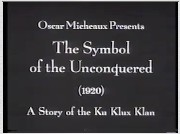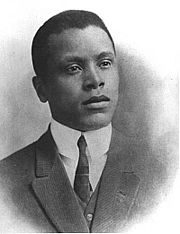I've finally finished watching Oscar Micheaux's fourth film--The Symbol of the Unconquered (1920) starring Iris Hall, Walker Thompson, and Lawrence Chenault.
The Symbol of the Unconquered is one of Micheaux's earliest surviving works. It was discovered in Belgium's National Film Archives and although some of the footage is still lost, the film was restored by The Museum of Modern Art in New York (with the help of Turner Classic Movies).
It was a bit hard for me to keep up with--probably due to some of the footage being lost, so in order to give this movie a thorough review, I will be breaking it down into some sections.
The Story
"Eve Mason, a very light-skinned Negro, leaves Selma, Alabama for the northwest town of Oristown to occupy the land she inherited from her grandfather. There she meets kindly Hugh Van Allen, who turns out to be her neighbor and he gives her a lift to her place outside of town. Jefferson Driscoll is another very light-skinned negro who wants to be taken as white, and he hates the negro race because his mother once interfered with his wooing a white girl. Driscoll gets in league with unsavory August Barr, an Indian fakir called Tugi, and horse thieves Bill Stanton and Philip Clark. When Driscoll intercepts a letter for Van Allen showing his land is on an oil field, the group posts notes on Van Allen's tent, threatening his life if he won't sell his land. Van Allen ignores the the notes, which are signed "The Knights of the Black Cross," leaves for town to buy furniture and won't be back for 48 hours..." (IMDb)
After a few months of watching Micheaux movies, I've come to realize that the man definitely had a "writer's mind" with great ideas and interesting plots in his head. Although a lot of his films were "reactions" to movies that were being put out by Hollywood, each of his movies had its own interesting twist to it.
However, I do notice a consistent problem in his movies--the structure never really stays as firm as it could and should. His movies sort of start out slow, then quickly began to take off, but right in the middle, things start to get confusing--the plot becomes muddled, seemingly rushed. Now, the reason for this could be because of poor editing (due to a small budget), or it could simply (and more than likely) be that Micheaux often got lost in his own writing. Reminds me very much of Orson Welles--both men with genius minds whose ideas unfortunately became entangled once they reached the their fingers.
Like other Micheaux movies, this one starts off sort of slow, but soon begins to take off with the introduction of one of the film's antagonists--Jefferson Driscoll (played excellently by Lawrence Chenault). Driscoll is a mixed race man who hates his blackness and hates black people. His history is his story--and his story drives the majority of this film. Soon, we are introduced to new characters--characters that don't necessarily drive the narrative, but do support. Unfortunately, this is where things begin to go wrong...
Lawrence Chenault as "Jefferson Driscoll" and Iris Hall as "Eve Mason"
Micheaux becomes a little too involved in giving us information on these supporting characters, therefore overshadowing the stories of the main characters. I was so busy trying to understand who was who and what their purpose was, that I forgot about the main storyline.
To make matters worse, we'll discover that the movie's climax--it's pivotal moment is part of the lost footage......
However, the sweet ending finally makes the movie worth sitting through, but it really doesn't do much to salvage that muddled middle.
****
Visuals
As mentioned before, Micheaux's films were usually made on small budgets. Therefore, the "look" of his films are never really that good--the lighting is pretty poor, the editing not so good, but it isn't completely unbearable. I must admit though, I did get a little kick out of the fact that some of the "night scenes" were clearly filmed during the day.
However, like in Within Our Gates--the climax of this film definitely stands out visually.
*Spoiler Alert*
The pivotal moment/climax of the film (like WOG) involves the Ku Klux Klan.
These men ride around on their horses with their torches--and the backdrop is completely black. The lights from the torches swiftly move about against the dark "night sky"--and although there is nothing pretty about the KKK, I found that particular moment and the way in which it was shot to be quite creepily beautiful.
****
Visuals
As mentioned before, Micheaux's films were usually made on small budgets. Therefore, the "look" of his films are never really that good--the lighting is pretty poor, the editing not so good, but it isn't completely unbearable. I must admit though, I did get a little kick out of the fact that some of the "night scenes" were clearly filmed during the day.
However, like in Within Our Gates--the climax of this film definitely stands out visually.
*Spoiler Alert*
The pivotal moment/climax of the film (like WOG) involves the Ku Klux Klan.
These men ride around on their horses with their torches--and the backdrop is completely black. The lights from the torches swiftly move about against the dark "night sky"--and although there is nothing pretty about the KKK, I found that particular moment and the way in which it was shot to be quite creepily beautiful.
****
The Leading Lady
The character of Eve Mason (played by Iris Hall)
Eve Mason is a kind and beautiful woman with a heart of gold. However, Eve is a bit different from other Micheaux ladies...
Sylvia Landry (played by Evelyn Preer) is the main character of 1920's Within Our Gates--she's kind and emphasis is placed on the fact that she is educated--and she does in fact drive the narrative.
Although Claudia (played by Dorothy Van Engle) is not the lead/main character of a later film--Murder in Harlem (1935), it is her intelligence and sharp-mind that not only drives the story, but brings it to its conclusion.
Eve Mason (Iris Hall) screaming in terror at an intruder.
Eve Mason--The Symbol of the Unconquered's lead and main character is kind, caring, and takes on any and all responsibilities--but there isn't much emphasis on Eve's educational background. We don't know much about her as an individual--instead, we know her through her relationships with other people, and (from what we see in the available footage) her character doesn't cause or stir up much action in the film.
But, as previously stated, there is something a little different about Eve...Eve actually takes on some physically challenging stuff!
But, as previously stated, there is something a little different about Eve...Eve actually takes on some physically challenging stuff!
Eve Mason with "Mother Driscoll" (Mattie Wilkes) and a neighbor.
Early in the film, Eve literally walks through a raging thunderstorm and actually stays outside throughout the entire thing (because at the time, she really has nowhere else to go); later on--without hesitation, she hops on a horse and rides like Paul Revere to seek help for her endangered friends (I can't really say the result of Eve's courage in this moment because this is when we reach the lost footage). Although we don't know much about Eve's educational background, we do realize that she may not be used to any physical labor--but she still accepts the challenge of single-handedly caring for her deceased grandfather's land.
In other words, Eve is more like a valiant soldier than any other Micheaux lady I've seen.
Oscar Micheaux was great at creating multidimensional characters for women, and so far, I believe Eve was probably his most standout character--and Iris Hall was a standout actress as well. It's unfortunate that there isn't much information about her on the internet.
****
It was hard for me to watch and critique The Symbol of the Unconquered without comparing it to Within Our Gates, but I have to say that it really did fall short. I was expecting a little more from this movie--more drama, perhaps more controversy, but then again--there is some missing footage. The lost footage could definitely be that "thing" that I feel is missing.
The Symbol of the Unconquered is still a great piece of history and the three lead actors do a great job of holding the film together--especially Lawrence Chenault. I really despised Chenault's character--and if you can make an audience hate your character, it's obvious that you are a phenomenal actor.
I give this movie a C+.
****
Click Here
to watch The Symbol of the Unconquered on Youtube
In other words, Eve is more like a valiant soldier than any other Micheaux lady I've seen.
Eve giving "Hugh Van Allen" (played by Walker Thompson) an important letter.
****
It was hard for me to watch and critique The Symbol of the Unconquered without comparing it to Within Our Gates, but I have to say that it really did fall short. I was expecting a little more from this movie--more drama, perhaps more controversy, but then again--there is some missing footage. The lost footage could definitely be that "thing" that I feel is missing.
The Symbol of the Unconquered is still a great piece of history and the three lead actors do a great job of holding the film together--especially Lawrence Chenault. I really despised Chenault's character--and if you can make an audience hate your character, it's obvious that you are a phenomenal actor.
I give this movie a C+.
****
Click Here
to watch The Symbol of the Unconquered on Youtube








No comments:
Post a Comment
Rude comments will be deleted. Irrelevant comments will be ignored.